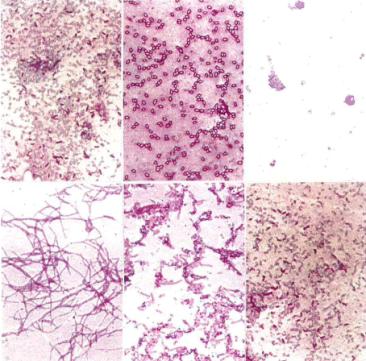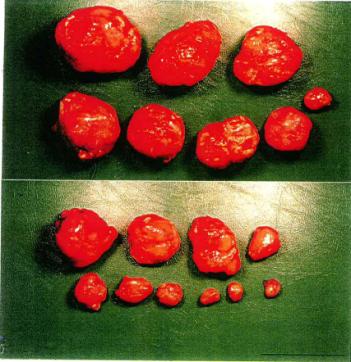Ultimate Charcoal Fibre
Made of Binchō-tan (white charcoal) powder with natural/synthetic fibre
|
| in Batting/Non-Woven Cloth Form |
 |
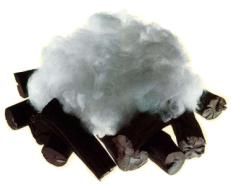 |
C21 is commercially supplied in the form of batting and impregnated non-woven
cloth and sprayed non-woven cloth.
|
|
|
| in Spun/Filament Yarn Form |
 |
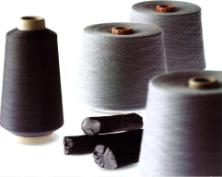 |
C21NX is blended in polyester and the yarns are commercially available with
the following specifications:
 70/30 cotton/polyester spun yarn in 30s or 40s counts 70/30 cotton/polyester spun yarn in 30s or 40s counts
 100 % polyester filament (150 dtex) 100 % polyester filament (150 dtex)
 100 % polyester staple fibre (6.7 dtex ü~ 51 mm) 100 % polyester staple fibre (6.7 dtex ü~ 51 mm) |
|
The ultimate charcoal fibre is human-friendly fibre to give comfort and
vital energy.
 Keeping warm in winter, and keeping dry in summer Keeping warm in winter, and keeping dry in summer
 Offering antibacterial and odour killing effect Offering antibacterial and odour killing effect
 Wide range of application possibilities Wide range of application possibilities
Use:
 For bedding materials For bedding materials
 For garments For garments
 For interior cloths For interior cloths
| Table 1. |
Thermal characteristics of C21 impregnated and spayed non-woven cloth
Thermal storage and release property by Infrared radiation exposure |
| Elapsed timeü@ |
ü@ü@ |
Measured temp. (üÄ)ü@ü@ |
Thermographic imageü@ |
| Blank |
Carbon
inner |
Carbon
spray |
30 sec.
After
exposureü@ |
Av. temp. |
29.5 |
41.8 |
41.1 |
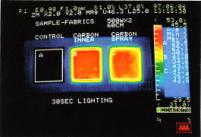 |
| Min. temp. |
29.1 |
34.8 |
36.5 |
| Max. temp. |
30.1 |
43.6 |
42.8 |
5 sec.
after
heat release |
Av. temp. |
29.1 |
38.5 |
37.3 |
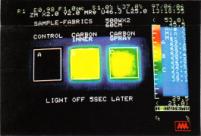 |
| Min. temp. |
28.8 |
32.8 |
33.3 |
| Max. temp. |
29.7 |
39.6 |
39.1 |
10 sec.
after
heat release |
Av. temp. |
28.8 |
35.2 |
34.1 |
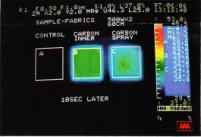 |
| Min. temp. |
28.5 |
31.3 |
31.3 |
| Max. temp. |
29.5 |
36.5 |
35.6 |
15 sec.
after
heat release |
Av. temp. |
28.5 |
33.1 |
32.3 |
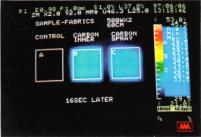 |
| Min. temp. |
28.2 |
30.5 |
30.5 |
| Max. temp. |
29.1 |
34.0 |
33.5 |
20 sec.
after
heat release |
Av. temp. |
28.3 |
32.0 |
31.2 |
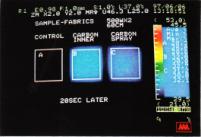 |
| Min. temp. |
28.0 |
30.0 |
30.0 |
| Max. temp. |
28.8 |
32.7 |
32.1 |
Table 2. Odour killing effect of C21
(1) Adsorbability on ammonia (initial concentration: 40 ppm)
| Sampleü@ |
Ammonia concentration (ppm) |
| Initial |
30 min. later |
2 hrs. later |
24 hrs. later |
| C21 |
40 |
10 |
8 |
3 |
| Blank |
40 |
37 |
35 |
32 |
(2) Adsorbability on acetic acid (initial concentration: 100 ppm)
| Sampleü@ |
Acetic acid concentration (ppm)ü@ü@ü@ |
| Initial |
30 min. later |
2 hrs. later |
24 hrs. later |
| C21 |
100 |
20 |
10 |
3 |
| Blank |
100 |
83 |
80 |
43 |
(3) Adsorbability on hydrogen sulfide (initial concentration: 15 ppm)
| Sampleü@ |
Hydrogen sulfide concentration (ppm)ü@ü@ü@ |
| Initial |
30 min. later |
2 hrs. later |
24 hrs. later |
| C21 |
15 |
12 |
8 |
2 |
| Blank |
15 |
15 |
13 |
13 |
Test conditions:
3.0 g sample was put in sampling bag (Tedlar® bag), and 3 liters specified
gas with specified concentration was injected. Then, gas concentration
was determined with detecting tube 0.5 hour later and at intervals of 2
hours up to 24 hours. (Test conducted by Kaken Test Center)
Table 3. Antibacterial effect of C21
| Sampleü@ |
Antibacterial efficacy evaluated by change in number of bacteria
(against Staphylococcus aureus) |
| Increase-decrease rate |
Increase or decrease |
Difference between
increase and decrease |
| C21 |
1.0 ü~ 10-7 or less |
- 1.0 or less |
4.0 or more |
| Blank (*) |
1.0 ü~ 103 |
3.0 |
-- |
(*) 100 % nylon standard white cloth
Test conditions:
Having the bacteria suspended on sterile liquid bouillon, and 0.2 ml was
took (including about 430,000 bacteria) to inoculate on 0.2 g sample. Then
the number of bacteria was counted after cultured at 37üÄ for 18 hours.
(Test conducted by Kaken Test Center)
| Table 4. |
Thermal characteristics of C21NX (athletic supporter) |
|
Thermal storage and release property by Infrared radiation exposure |
Elapsed
timeü@ |
ü@ü@ |
Measured temp. (üÄ)ü@ |
Thermographic imageü@ |
| C21NX |
Control |
Before
exposureü@ |
Av. temp. |
23.1 |
23.0 |
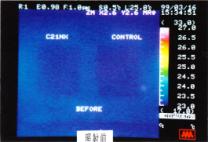 |
| Min. temp. |
23.0 |
23.0 |
| Max. temp. |
23.3 |
23.2 |
60 sec.
after
exposure |
Av. temp. |
31.2 |
26.0 |
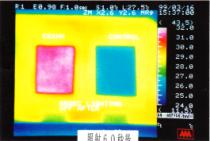 |
| Min. temp. |
30.7 |
25.7 |
| Max. temp. |
31.7 |
26.7 |
10 sec.
after
heat
release |
Av. temp. |
29.0 |
25.2 |
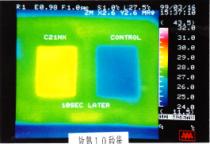 |
| Min. temp. |
28.6 |
25.0 |
| Max. temp. |
29.3 |
26.0 |
20 sec.
after
heat
release |
Av. temp. |
27.6 |
24.8 |
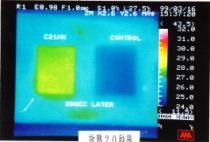 |
| Min. temp. |
27.3 |
24.6 |
| Max. temp. |
28.0 |
25.5 |
30 sec.
after
heat
release |
Av. temp. |
26.6 |
24.6 |
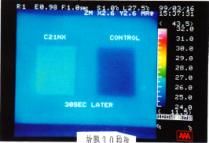 |
| Min. temp. |
26.3 |
24.3 |
| Max. temp. |
27.0 |
25.0 |
Table 5. Odour killing effect of C21NX
(4) Adsorbability on ammonia (initial concentration: 40 ppm)
| Sampleü@ |
Ammonia concentration (ppm)ü@ü@ü@ |
| Initial |
30 min. later |
2 hrs. later |
24 hrs. later |
| C21NX |
40 |
37 |
33 |
17 |
| Blank |
40 |
39 |
38 |
26 |
(5) Adsorbability on acetic acid (initial concentration: 100 ppm)
| Sampleü@ |
Acetic acid concentration (ppm)ü@ü@ü@ |
| Initial |
30 min. later |
2 hrs. later |
24 hrs. later |
| C21NX |
100 |
64 |
51 |
14 |
| Blank |
100 |
71 |
66 |
34 |
(6) Adsorbability on hydrogen sulfide (initial concentration: 15 ppm)
| Sampleü@ |
Hydrogen sulfide concentration (ppm)ü@ü@ü@ |
| Initial |
30 min. later |
2 hrs. later |
24 hrs. later |
| C21NX |
15 |
13 |
13 |
13 |
| Blank |
15 |
15 |
15 |
14 |
Test conditions:
1.0 g sample was put in sampling bag (Tedlar® bag), and 3 liters specified
gas with specified concentration was injected. Then, gas concentration
was determined with detecting tube 0.5 hour later and at intervals of 2
hours up to 24 hours. (Test conducted by Kaken Test Center)
Table 6. Antibacterial effect of C21NX
| Sampleü@ü@ |
Antibacterial efficacy
(against Staphylococcus aureus ATCC 6538P)ü@ü@ |
| Number of active bacteria |
Bacteriostatic activity |
Bactericidal activity |
| C21NX |
9.5 ü~ 103 |
3.9 |
1.5 |
Blank:
right after inoculated |
2.7 ü~ 104 |
--ü@ |
--ü@ |
Blank:
18 hours after inoculated |
8.4 ü~ 103 |
--ü@ |
--ü@ |
(*) 100 % nylon standard white cloth
Test conditions: JIS L 1902 (Test conducted by Kaken Test Center)
Specialty ofBinchō-tan
Binchō-tan or white charcoal is a traditional charcoal of Japan. It dates to the Edo period, when during
the Genroku era, a craftsman named Bitchū-ya Chōzaemon began
to produce it in Tanabe, Wakayama. The raw material is oak, specifically
ubame oak (Quercus phillyraeoides), which is designated as the official symbolic tree of Wakayama Prefecture.
Wakayama is the major production site of high-quality charcoal, and it
has designated the traditional production technique of Binchō-tan as an intangible cultural heritage
Traditional production process:
 |
 |
 ü@ ü@ |
 |
| ć@ Cut out raw woods (20 - 40 year-old Quercus phillyraeoides or Quercus
glauca) |
ćA Day 1st: put raw woods in the kiln |
ćB Day 2nd - 3rd: dry raw woods (vapoured with white smoke) |
ćC Day 4th - 6th: Keep firing the kiln |
 |
 |
 |
ü@ |
| ćD Day 6th - 7th: after charred them, open the kiln gradually to introduce
air and burn bark so that they are glowing |
ćE Day 7th - 8th: put them out one by one carefully |
ćF Collect them on coal bed, and sprinkle powders of micronized coal on
them. |
ü@ |
Superior absorbability of Binchō-tan is due to its numerous small pores. Their superficial area per 1 gram
spans about 300 square meters. In spite of its sponge-like structure, Binchō-tan is harder than black charcoal, and rings with a metallic sound when struck.
Possible anticancer effect
It has been discovered that some nameless species of bacteria exist in
Binchō-tan as shown in the following microscopic images dyed with phenosafranine
(10 ü~ 100 = 1000). (investigated by the national institute of advanced
industrial science and technology, Japan)
Experimentation to check any of effect of these bacteria on sarcoma was
carried out. The following pictures show a series of sarcomas in original
state (upper) and the same 28 days after these bacteria were injected to
them (lower). Shrunk sarcomas may suggest possible anticancer effect of
these bacteria.
(C) copyright 2011 Venture Chemical Ltd.All Right Reserved. |
|

















 ü@
ü@



